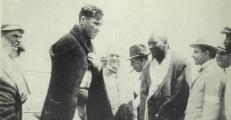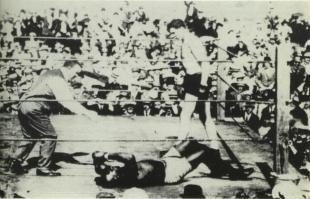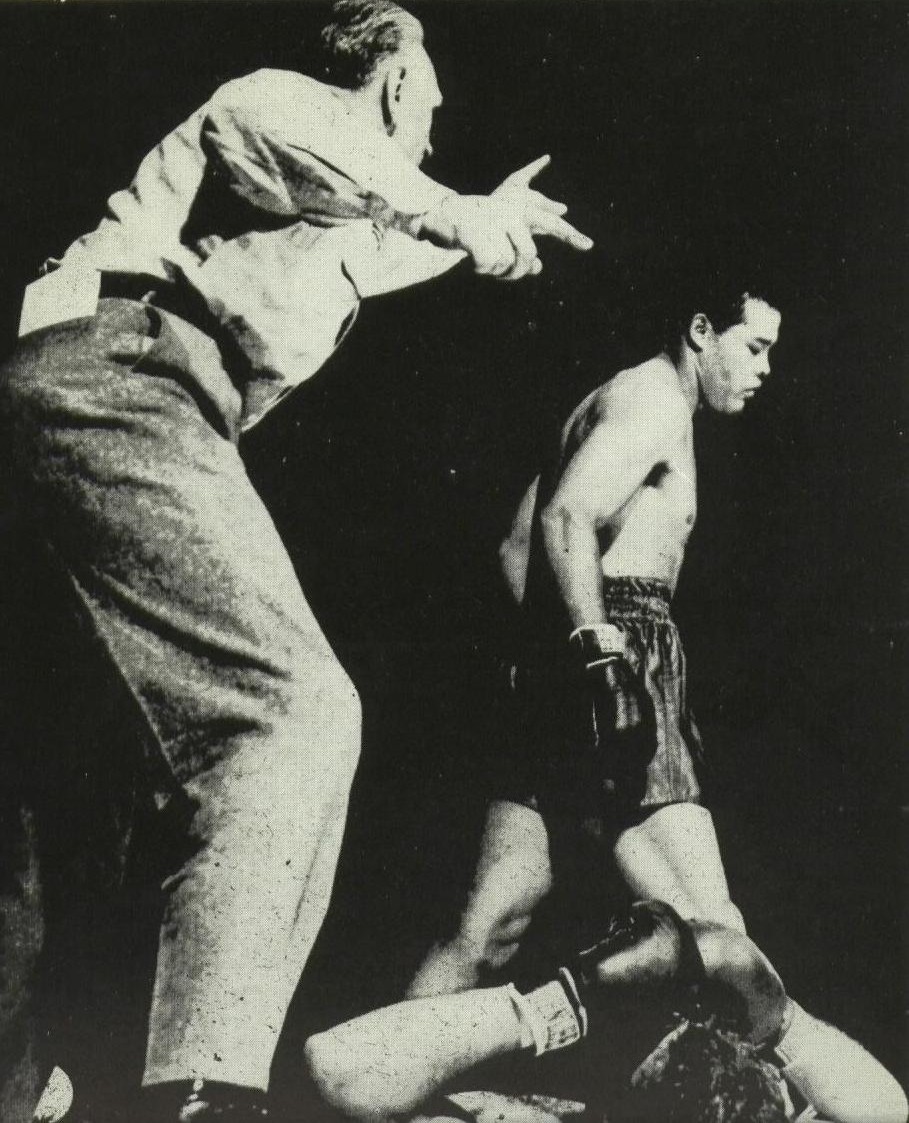
By Monte D. Cox

When Jack Johnson took the heavyweight title from Tommy Burns and defeated the once great Jim Jeffries in an ill-fated comeback the search was on for the “great white hope.” From 1908 when he won the title until his 1915 match with big Jess Willard, the heavyweight champion attracted more attention than any other black American in history up until the time of Joe Louis and was the most controversial black athlete until Muhammad Ali.
Johnson was the epitome of the “bad nigger.” The origins and use of “bad” by blacks as a term of admiration can be traced to slavery. A “bad nigger” was one who would not submit to his shackles and resisted the supremacy of the white man (Gilmore p 13). Jack Johnson refused to bow down to the white man and defiantly said by his actions “I am better and stronger than any white man alive.” The white race, for the most part, had a difficult time accepting the fact of Johnson’s dominance of the heavyweight division. One observer went so far to say, after Jeffries defeat, that Johnson wasn’t really a Negro; he was a Numidian- from a long lost tribe of Caucasians (Gilmore p 45).
Most experts and boxers had picked former heavyweight champion Jim Jeffries to defeat Johnson in the ring. John L. Sullivan, James J. Corbett, Robert Fitzsimmons, Tommy Burns, Abe Attell, Battling Nelson all picked Jeff to win. Even black boxers like Sam Langford and Joe Jeanette picked the white man. Perhaps Jeanette, who had fought Johnson more than any other man spoke for them all when he said, “Why Jeffries can lose half of his strength, have his endurance cut in two, carry a ton of extra weight and still whip Johnson” (Roberts p 102). But such was not the case as the wonderful Negro boxer totally dominated the once unbeaten Jeffries and stopped him in the 15th round, a result, which induced riots, lynchings, beatings, and other white on black, and black on white violence.
To add fuel to the fire is the fact that it wasn’t enough for Johnson to be superior in the ring to a white man, he also had to have affairs with and marry white women, which challenged the white man sexually. “There is no getting around it”, wrote his biographer, “Johnson always had women in his entourage and they were always white and blonde.” (Farr p 72) Johnson’s flashy clothes, fast cars, white women and his antics both in and out of the ring made him a menace to the white establishment and that menace must be stopped by any means necessary. Johnson was pursued on charges that he violated the Mann Act, which was instituted by Congress as a means of regulating prostitution and prohibited the interstate transportation of women for “immoral purposes.” Johnson was eventually charged, and found guilty and forced to flee the country.
That Johnson was a great fighter there can be no doubt. Johnson’s “mastery of ring science, his ability to block, counter, and feint, are still unexcelled,” wrote Ring founder Nat Fleischer in 50 Years at Ringside.
Historian and writer Gilbert odd stated, “Jack’s skill at leading, picking his punches and whipping in precision blows was unequalled, so too was his uncanny ability to deflect punches aimed at him or to make them miss by a fraction of an inch by as he drew back his head. His left jab was straight and true, his right-cross sheer artistry, while his uppercuts were devastating. He was an expert at drawing an opponent into his blows, and of course, as they advanced so met with double impact, “They just knock themselves out”, he was fond of saying.”
Like Muhammad Ali would later be considered, Jack Johnson was as close to unbeatable as any heavyweight champion in history. He had a 10 year unbeaten streak which speaks volumes about his ability in the ring.
Convicted in the United States in 1913 on fallacious charges Johnson fled to Paris. Johnson had few opportunities to defend his title in Europe; he survived by giving exhibitions and doing some work on stage. He successfully defended his title twice against Jim Johnson, and Frank Moran awaiting serious challenges.
In 1914 negotiations with promoter Jack Curley, in partnership with Harry Frazee, and Jack Johnson virtually assured a big money heavyweight championship for Johnson against another white hope. Curley had the financial backing of Lawrence Weber and Frazee, who were theatrical producers, and therefore had the confidence of Johnson. The champion was guaranteed $30,000 win or lose.
Frazee had suggested to Curley that Johnson was getting older and his days as champion were numbered. Curley thought he had just the man to beat him, the Pottawatomie Giant, Jess Willard (B.D Vol.4 p 110).
Jess Willard was truly a giant of a man. He stood 6’6 ¼” and weighed 230 pounds, he had a reach of 83” inches which is among the best in heavyweight history. Willard had a solid left jab and a good right hand, the endurance to fight 25 plus rounds and the power enough to kill a man in the ring with a single blow, which unfortunately occurred in his fight against Bull Young in 1913.
Willard was a direct product of the “white hope” fanaticism that prevailed while Jack Johnson was the champion. Boxing was a very popular sport in the teens every major urban city had boxing gyms in those days. Every white athlete wanted to be a fighter to restore honor to the white race. Jess began boxing at age 26 and didn’t turn pro until he hit 29. He was 34 at the time of the Johnson fight but at his peak as a fighter. He was a bit crude but he had strength, power, durability and endurance.
Jack Curley and Tex O’Rourke devised a plan to take advantage of those assets in order to defeat the black heavyweight champion. First they made it a finish fight scheduled for 45 rounds in Havana, Cuba under a hot sun. O’Rourke prepared Willard for a lengthy bout by strengthening the challengers legs by running him up hills and over rough terrain. According to Fleischer by the time of the fight he was a match for any man in terms of endurance (50 years p 85). The fight plan was to use the Willard’s reach and height advantages to avoid Johnson’s speed in the early rounds and then eventually wear down the champion in the later rounds. Willard trained with dogged determination. He pummeled his sparring partners, one of them Walter Menahen suffered a broken nose (Roberts p 200).
Two days before the fight, the well-trained Willard who was in the best shape of his life, became sullen and restless. He had a bad case of pre-fight nerves and had doubts as to whether he could beat the magnificent Johnson. Then fate intervened.
Nat Fleischer told the story that follows of the “black duck” that inspired Willard to believe he could defeat Johnson. The story is taken from Fleischer's book "Black Dynamite" Vol 4 Chapter 8. "On the morning of the fight Willard, his trainer Tex O’Rourke, and Fleischer were strolling along the beach when they spotted a dark spot in the distant sky. It was a black duck, flying from the direction of the Florida coast, many miles away. It had lost its way and was seeking a place to rest.
Bravely it flew against a half gale with huge seas pounding below. Twice, with wearily flapping wings, it sank to the waves. Each time it made a frantic effort to rise again. Spent and almost exhausted, the bird cleared the breakwater grazed the huge sea wall, flew about 50 feet upward, then like a stone, fell almost at Jess’s feet.
Gently the giant picked up the gallant, feathered fighter. Tenderly like a mother nursing her ailing child, he held the duck to his chest. But in a few seconds the bird’s heart stopped beating. It had made its landfall, and had perished in the attempt.
Jess stood there, silent and motionless, stroking the sea-drenched feathers. He looked at O’Rourke and said softly, “Tex, too bad he had to hand in his check just as he reached the end of the trail. What a game bird!” Sunk in moody thought Willard went on stroking the dead bird. As we watched in amazement, wrote Fleischer, we saw him change. His eyes brightened, is broad back straightened. He turned to O’Rourke, slapped him on the back and cried, “I’ll knock Johnson cuckoo. Tonight, I’ll be the world heavyweight champion. This bird has shown me something!” Willard went on, “Could there be a better omen for me than this poor bird? That duck flew all the way from Florida. He flopped at my feet. And this is how I see it. This fight is going to be a long and hard but at the end the Johnson will fall at my feet just like this black duck did.” (50 Years pp 85-86)
Johnson attacked Willard with ferocity in the early rounds. In the opening session, Johnson twice threw thudding left hooks, but Jess was fighting according to instructions and caught the blows on arms, slowly backing away the whole time. Jack feinted a left and smashed a right cross to the jaw that momentarily buckled Willard, then he backed up. Willard was defending pretty well using his long arms, gloves and elbows for defense while backing away from Johnson’s attack. (50 Years p 87).
From the second round on Johnson cut loose with cold savage fury that punished Jess despite his strategy. In the seventh a shattering blow to the jaw had Willard walking back to his corner on unsteady legs. Johnson dominated the eighth round gunning for a knockout over the seriously wide margin and tried to knock Willard out. But the big man proved to have the grit to take quite a whipping. He had heart just like that determined black duck. (50 Years p 88)
After 15 rounds Johnson was ahead by a wide margin. Then starting about the 16th round Johnson began to slowly tire (ibid). By the 18th round it seemed as Johnson knew that he was licked. In the 20th O’Rourke told Willard, “Keep on him, he’s tiring” (ibid). The tables were now turned and Willard was on the offensive while Jack went on the defense doing his best to keep the fight close. In the 26th round a right to the chin dropped Johnson to the canvas where he was counted out. The heavyweight championship was back in the hands of the white race and this ended one of the most racially motivated periods in sports history.
Later Johnson claimed he threw the fight. The famous picture of Johnson lying on the canvas with his arms over his face supposedly shielding his eyes from the sun is badly misinterpreted.  There are other fights where fighters have been knocked out and have their arms in the exact same position. There is a picture of Billy Conn where he has both of his hands over his eyes while lying on his back after having been brutally knocked out by Joe Louis (below right).
There are other fights where fighters have been knocked out and have their arms in the exact same position. There is a picture of Billy Conn where he has both of his hands over his eyes while lying on his back after having been brutally knocked out by Joe Louis (below right). One can clearly see Conn in the same position after having been hurt and knocked out. A more recent example is the Evander Holyfield knock out of Buster Douglas where Douglas also rolls over in the same position as Johnson in the Willard fight with his arms momentarily over his eyes. Go watch the film and see it for yourself.
One can clearly see Conn in the same position after having been hurt and knocked out. A more recent example is the Evander Holyfield knock out of Buster Douglas where Douglas also rolls over in the same position as Johnson in the Willard fight with his arms momentarily over his eyes. Go watch the film and see it for yourself.
If one watches the film of the Johnson-Willard bout it is clear that Willard simply hits Johnson on the chin with a long looping right hand that lands with full force and knocks him out. Mike Tyson, a historian as well as a heavyweight champion, on the HBO video "Tyson and the Heavyweights (1988)" agrees saying, "to me it just looks like he gets hit on the chin." The punch is in a downward angle right on the top of the chin that according to Rick Clark, a karate master who specializes in pressure point theory, a strike to this point -conception vessel 24- is a certain knockout blow (Clark p. 39). A right to the heart had weakened Johnson the previous round making the final blow to the chin even more shocking to the body. Johnson gets nailed hard and is knocked unconscious.
Certainly Jack Welsh, who had referred the bout, did not believe that the fight was fixed. He said that Johnson was so confident that the night before the match the he bet $2,500 on himself to win (Roberts p 201). No one waits 26 rounds to throw a fight no matter what there excuse is. Johnson merely under-estimated the big, lanky giants ability to absorb punishment and miscalculated the effects that age, inactivity, and fast living had taken upon him.
To this day Johnson’s claim of throwing the fight, though completely untrue, has caused many followers of the sport to disregard Jess Willard’s victory over the great Johnson, and to downplay the big mans ability. Willard was not a greatly skilled fighter but his stamina, toughness, and power should not be under-appreciated in a long fight.
After the fight Johnson remained in exile unable to get a passport to return to the United States. Johnson returned to Europe acting doing a revue entitled “Seconds Out” in which he boxed, sang and played various musical instruments, though the show was not a huge success. In 1920 he eventually returned to the U.S. and spent a little less than a year in a Leavenworth prison. Johnson refused to yield to his fast living and it eventually caught up with him when he died in a car crash on June 10, 1946 at the age of 68.
Willard held onto the title for four years but only defended it once successfully. On July 4, 1919 in Toledo, Ohio he ran into a young, hungry slugger named Jack Dempsey who annihilated him in taking the title. Jess Willard lived to the age of almost 87, when he died on December 15, 1968.
References
Clark, Rick. 1992. Martial Arts for The University. Kendall/Hunt Publications. Dubuque, Ia.
Finnis Farr. 1964. Black Champion. Fawcett Publications. Greenwich, Conn.
Fleischer, Nat. 1939. Black Dynamite, Vol. 4. The Fighting Furies. Ring Athletic Library Book No. 18. C.J. O’Brien Inc. NYC. Chapter 1. Jack Johnson, The Galveston Wonder.
Fleischer, Nat. 1958. 50 Years at Ringside. Fleet Publishing Corp. NY.
Gilmore Al-Tony 1975. Bad Nigger. Kennikat Press. Port Washington, NY.
McCallum, John. 1975 The Encyclopedia of World Boxing Champions. Chilton Book. Co. Radnor, Pa.
Odd, Gilbert. 1974. Boxing the Great Champions. Hamlyn Publishing Group. London.
Roberts, Randy. 1983. Papa Jack: Jack Johnson and the Era of the White Hopes. Free Press. NY, NY.